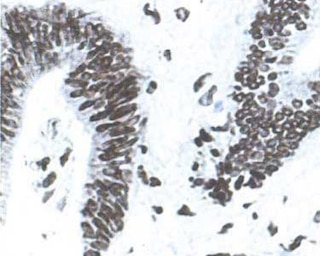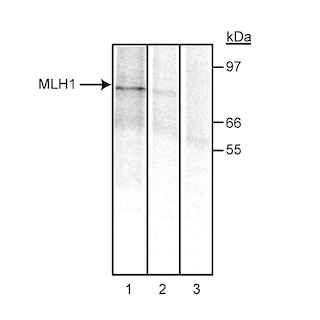-
Your selected country is
Middle East / Africa
- Change country/language
Old Browser
This page has been recently translated and is available in French now.
Looks like you're visiting us from {countryName}.
Would you like to stay on the current country site or be switched to your country?
BD Pharmingen™ Purified Mouse Anti-MLH-1 with Control
(RUO)





Western blot analysis of MLH1. Lysate from Jurkat cells were probed with anti-MLH1 (clone G168-15, Comp. No. 51-1327GR) at concentrations of 2.0 (lane 1), 1.0 (lane 2), and 0.5 µg/ml (lane 3). MLH1 is identified as a band between 80-85 kDa.

Immunohistochemiical staining: Acetone-fixed, frozen tissue section of human colon carcinoma stained for MLH1 (clone G168-15, Cat. No. 550838) using a DAB chromogen and Hematoxylin counterstain. Cells expressing MLH-1 can be identifed by the intense brown labeling of their cell nuclei.


BD Pharmingen™ Purified Mouse Anti-MLH-1 with Control

BD Pharmingen™ Purified Mouse Anti-MLH-1 with Control

Purified Mouse Anti-MLH-1 with Control
Regulatory Status Legend
Any use of products other than the permitted use without the express written authorization of Becton, Dickinson and Company is strictly prohibited.
Preparation And Storage
Recommended Assay Procedures
Applications include western blot analysis (0.5-2.0 µg/ml) and immunohistochemical staining of frozen and paraffin-embedded tissue sections (5-20 µg/ml). Jurkat control lysate [50 µg (1 µg/µl)] is provided as a western blot control (Comp. No. 51-16526N; store lysate at -20°C). Additional Jurkat control lysate (Cat. No. 611451) is sold separately. Intestine or normal colon is suggested as a positive control for immunohistochemical staining. In intestine, staining is primarily nuclear and is seen in the crypts of Lieberkuhn, similar to that described in the literature. Both nuclear and cytoplasmic staining have been observed in a variety of other normal and tumor tissue and cell types. This clone is also available as Cat. No. 550838 in our special formulation for IHC application. Clone G168-728 (Cat. No. 554073) is recommended for immunoprecipitation of MLH1.
Product Notices
- Since applications vary, each investigator should titrate the reagent to obtain optimal results.
- Caution: Sodium azide yields highly toxic hydrazoic acid under acidic conditions. Dilute azide compounds in running water before discarding to avoid accumulation of potentially explosive deposits in plumbing.
- Source of all serum proteins is from USDA inspected abattoirs located in the United States.
- Please refer to www.bdbiosciences.com/us/s/resources for technical protocols.
- Sodium azide is a reversible inhibitor of oxidative metabolism; therefore, antibody preparations containing this preservative agent must not be used in cell cultures nor injected into animals. Sodium azide may be removed by washing stained cells or plate-bound antibody or dialyzing soluble antibody in sodium azide-free buffer. Since endotoxin may also affect the results of functional studies, we recommend the NA/LE (No Azide/Low Endotoxin) antibody format, if available, for in vitro and in vivo use.
Companion Products




| Description | Quantity/Size | Part Number | EntrezGene ID |
|---|---|---|---|
| Purified Mouse Anti-Human MLH-1 | 50 µg (3 ea) | 51-1327GR | N/A |
| Jurkat Cell Lysate | 50 µg (1 ea) | 51-16526N | N/A |
Development References (8)
-
Baker SM, Plug AW, Prolla TA. Involvement of mouse Mlh1 in DNA mismatch repair and meiotic crossing over. Nat Genet. 1996; 13(3):336-342. (Immunogen: Western blot). View Reference
-
Cleaver JE. It was a very good year for DNA repair. Cell. 1994; 76(1):1-4. (Biology). View Reference
-
Fishel R, Ewel A, Lee S, Lescoe MK, Griffith J. Binding of mismatched microsatellite DNA sequences by the human MSH2 protein. Science. 1994; 266(5189):1403-1405. (Biology). View Reference
-
Li GM, Modrich P. Restoration of mismatch repair to nuclear extracts of H6 colorectal tumor cells by a heterodimer of human MutL homologs. Proc Natl Acad Sci U S A. 1995; 92(6):1950-1954. (Biology). View Reference
-
Prolla TA, Christie DM, Liskay RM. Dual requirement in yeast DNA mismatch repair for MLH1 and PMS1, two homologs of the bacterial mutL gene. Mol Cell Biol. 1994; 14(1):407-415. (Biology). View Reference
-
Prolla TA, Pang Q, Alani E, Kolodner RD, Liskay RM. MLH1, PMS1, and MSH2 interactions during the initiation of DNA mismatch repair in yeast. Science. 1994; 265(5175):1091-1093. (Biology). View Reference
-
Su SS, Modrich P. Escherichia coli mutS-encoded protein binds to mismatched DNA base pairs. Proc Natl Acad Sci U S A. 1986; 83(14):5057-5061. (Biology). View Reference
-
Wilson TM, Ewel A, Duguid JR. Differential cellular expression of the human MSH2 repair enzyme in small and large intestine. Cancer Res. 1995; 55(22):5146-5150. (Biology). View Reference
Please refer to Support Documents for Quality Certificates
Global - Refer to manufacturer's instructions for use and related User Manuals and Technical data sheets before using this products as described
Comparisons, where applicable, are made against older BD Technology, manual methods or are general performance claims. Comparisons are not made against non-BD technologies, unless otherwise noted.
For Research Use Only. Not for use in diagnostic or therapeutic procedures.
Report a Site Issue
This form is intended to help us improve our website experience. For other support, please visit our Contact Us page.